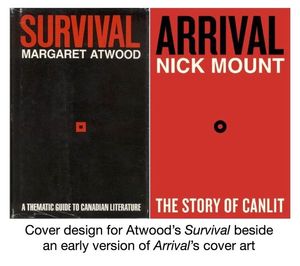Nick Mount on the CanLit Boom of the 1960s & What It Meant for Canada
Former Walrus fiction editor and beloved U of T professor Nick Mount knows a thing or two about Canadian literature. Not only did he discover and boost many new voices during his time at the Walrus, but he's also considered one of the country's leading thinkers on our national literature, winning accolades and awards for his doctoral dissertation about early 20th Canadian literature, his research, and his teaching.
So it's no surprise that he was the right person to tackle the story of one of CanLit's most dynamic periods, the so-called CanLit boom that began in the late 1950s and carried on into the mid-1970s. The result of his research and reading is Arrival: The Story of CanLit (House of Anansi), an instant-classic for CanLit nerds and patriotic bookworms. The book covers titans like Atwood, Ondaatje, Purdy, Munro, Richler, Cohen, and more, but goes much deeper into the works and impact of these household names than has previously been done.
We're thrilled to welcome Nick to Open Book today as part of our Entitled interview series, to talk about why "Arrival" was the right name for this complex story. He tells us about the seminal text that saved House of Anansi 45 years ago, shares a memorable (and PG-13) poem title that stuck with him, and explains why he'll leave the story of the next generation of CanLit to another writer.
Open Book:
Tell us about the title of your newest book and how you came to it.
Nick Mount:
My new book is called Arrival: The Story of CanLit. It’s about the explosion of Canadian literature that took place between the late 1950s and the mid-1970s, the so-called CanLit Boom. It’s the story of the writers who emerged at that time—people such as Margaret Atwood, Mordecai Richler, Alice Munro, Marie-Claire Blais, Leonard Cohen, and many others—and of the society that produced, published, and read them.
My first book, When Canadian Literature Moved to New York, was about an earlier moment in Canada, a time when being a Canadian writer almost necessarily meant publishing and often living outside the country. The working title for that book was “Exodus.” I suspect Arrival came to mind for my new book partly as a response to my first book and to the story it tells, a story of departure.
It wasn’t until after I’d settled on the title that I realized it also paired nicely with the title of Margaret Atwood’s 1972 book, Survival: A Thematic Guide to Canadian Literature. Atwood and her publisher—my publisher, House of Anansi—called the book “Survival” not just because survival was the main theme it found in Canadian writing, but because surviving was what Canadian literature did. Survival sold 50,000 copies in three years. It saved Anansi and demonstrated a literature whose existence its title doubted. In the 1960s, Canadian literature didn’t just survive—it arrived. My book is about how that happened.
In fact, our first run at a cover was a deliberate homage/reply to Atwood’s book. I liked it, but the publisher felt it lacked excitement. The images on the final cover are also an effective way to say something the title doesn’t, that this is a story that takes place in the 1960s, a time of many other changes.
OB:
What, in your opinion, is most important function of a title?
Your CanLit News
Subscribe to Open Book’s newsletter to get local book events, literary content, writing tips, and more in your inbox
NM:
I write non-fiction, so for me the most important function of a title is simply to say what the book is about, hopefully in a memorable way. In this case, getting the word “story” in the title was important to me because it helps tells readers something about not just the subject but the method of the book.
OB:
What is your favourite title that you've ever come up with and why? (For any kind of piece, short or long.)
NM:
In the late ‘90s, I wrote a piece for a Halifax magazine in praise of the Spice Girls and their movie, Spice World. Even then, I was substantially older than the typical Spice Girls fan. I called the piece "Old Spice".
OB:
What about your favourite title as a reader, from someone else's work?
NM:
It’s pretty hard to top Heather O’Neill’s Lullabies for Little Criminals. Zsuzsi Gartner’s Better Living Through Plastic Explosives would also be a contender.
In Canadian poetry, the best title I know of is for a poem in Al Purdy’s first book: “For Norma in Lieu of an Orgasm.”
OB:
Did you consider any other titles for your current book and if so what were they? Why did you decide to go with the title you eventually picked?
NM:
The working title for most of the book’s life was simply “The CanLit Boom of the 1960s.” Functional, but boring. I also considered “The Rise and Fall of CanLit,” but it risked misrepresenting my argument and had already been used (by Matt Cohen in Saturday Night magazine in 1979).
Contractually, the title is the publisher’s decision, not the author’s. So you’d have to ask Anansi this question. Not everyone at the press was crazy about “Arrival”—some thought it wasn’t specific enough, and that the reference to Atwood’s Survival was too insider for a general audience. They’re probably right on both counts. In the end, I suspect we kept the title for the same reason bands often keep a name they thought was temporary—because they lived with it for long enough that it became who they were.
OB:
What are you working on now?
NM:
Getting ready for classes in September, as well as writing a lecture series based on Arrival that I hope to make available on YouTube.
I have toyed with a sequel to Arrival, but I’m not sure I’m the right person to write it. My distance from the people and events in Arrival let me tell the story as honestly as I could, but I think I might be too close to many Canadian writers of the next generation, my generation, to write objectively about them. We’ll see.
_________________________________
Nick Mount is a professor of English literature at the University of Toronto, award-winning critic, and former Fiction Editor at The Walrus. He regularly gives public talks on the arts in Canada, and has appeared on TVO’s Big Ideas and CBC Radio’s Sunday Edition. He is a two-time finalist in TVO’s Best Lecturer Competition. In 2011, he was awarded a 3M National Teaching Fellowship, the country’s highest teaching award. He lives in Toronto.





